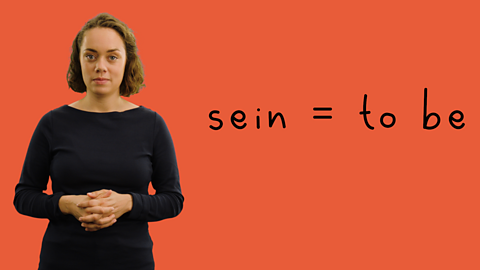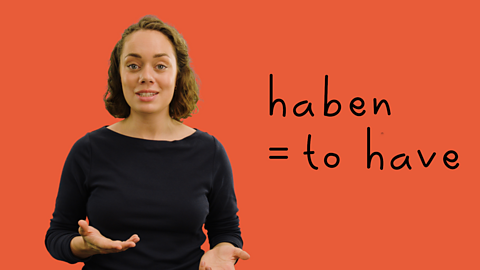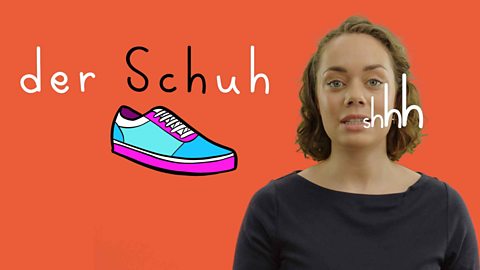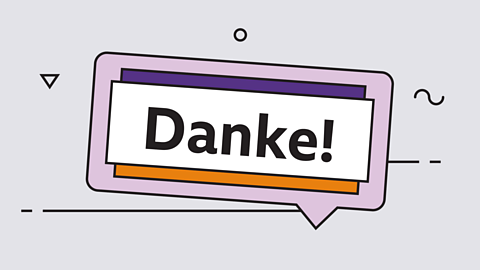A noun is a person, place or thing. All German nouns must start with a capital letter and they all have a gender: masculine, feminine or neuter.
How to use genders and articles in German
All nouns in German are either masculine, feminine or neuter.
When you learn that the word for dog is Hund, learn that it’s a masculine noun - der Hund.
For masculine nouns der means ‘the’ - der Hund - ‘the dog’.
For feminine nouns die means ‘the’ - die Katze - ‘the cat’.
And for neuter nouns das means ‘the’ - das Kaninchen - the rabbit.
There’s also more than one word for ‘a’. So ein is ‘a’ for masculine nouns - ein Hund.
Eine is ‘a’ for a feminine nouns - eine Katze and ein is ‘a’ for a neuter nouns - ein Kaninchen.
So how do you know the gender of a noun? Well, there are clues to help you. Sometimes the gender is logical: ‘father’ is masculine - der Vater and ‘mother’ is feminine - die Mutter.
Sometimes there are groups of nouns that are a certain gender. For example the days of the week are masculine - der Montag, and lots of drinks are also masculine too der Kaffee.
Words ending in e are usually feminine - die Lampe - ‘the lamp’.
Whereas words borrowed from English are usually neuter for example das Internet, das Baby.
It’s really good to learn the gender with the noun so you know whether it’s der, die or das or ein, eine or ein.
Genders
The gender is important as it decides lots of things around the noun, like articles and adjectives. Nouns are also either singular or plural. Here are some clues to help you work out the gender.
Masculine
- Male family members
- der Vater - father
- der Bruder - brother
- der Junge - boy
- Days, months and seasons
- der Montag - Monday
- der Juni - June
- der Winter - winter
- Nouns ending in -ling and -ig
- der Hon_ig_ - honey
- der Kön_ig_ - king
- der Schmetter_ling_ - butterfly
Feminine
- Female family members
- die Mutter - mother
- die Schwester - sister
- die Oma - grandma
- Nouns ending in -e
- die Katz_e_ - cat
- die Lamp_e_ - lamp
- Nouns ending in -schaft
- die Freund_schaft_ - friendship
- die Land_schaft_ - countryside
- die Nachbar_schaft_ - neighbourhood
Neuter
- Human and animal babies
- das Baby - baby
- das Kätzchen - kitten
- das Küken - chick
- Nouns ending in -chen
- das Kanin_chen_ - rabbit
- das Mäd_chen_ - girl
- Verbs used as nouns
- das Leben - life
- das Essen - food
- das Einkaufen - shopping
Articles
The definite article: der, die and das
The definite article is the word for the. There are four different definite articles in German, depending on the gender and number of the noun. Take a look at them in the table below.
| Gender/Number | Definite article (the) | Example |
|---|---|---|
| masculine | der | der Hund - the dog |
| feminine | die | die Katze - the cat |
| neuter | das | das Kaninchen - the rabbit |
| plural | die (even if the noun is masculine or neuter) | die Hund_e_ - the dogs, die Katze_n_ - the cats |
The indefinite article: ein, eine and ein
The indefinite article is the word for a and an. There are three different indefinite articles in German. Take a look at them in the table below.
| Gender | Indefinite article (a/an) | Example |
|---|---|---|
| masculine | ein | ein Hund - a dog |
| feminine | eine | eine Katze - a cat |
| neuter | ein | ein Kaninchen - a rabbit |
There is no plural indefinite article. Ein, eine and ein are only used for singular nouns.
Nominative and accusative
The article changes depending on where the noun is used in the sentence. This is called the German Case System.
Nominative
The nominative case is used when the noun is the subject of the sentence. The subject is the person or thing who ‘does’ the verb in the sentence.
- Der Mann hat einen Hund - The man has a dog.
- Ein Mann hat einen Hund - A man has a dog.
Take a look at the nominative definite and indefinite articles below.
| definite article | indefinite article | |
|---|---|---|
| masculine | der | ein |
| feminine | die | eine |
| neuter | das | ein |
| plural | die |
Accusative
The accusative case is used when the noun is the direct object in the sentence. This means it has the verb ‘done to it’. It often comes after the verb.
- Der Mann hat einen Hund - The man has a dog.
- Ein Mann hat einen Hund - A man has a dog.
Take a look at the accusative definite and indefinite articles below.
| definite article | indefinite article | |
|---|---|---|
| masculine | den | einen |
| feminine | die | eine |
| neuter | das | ein |
| plural | die |
Forming plurals
If a noun is plural, you need to use the article die. To make a German noun plural, you can’t simply add s like in English. Plurals in German have different endings depending on the noun. Masculine and neuter nouns often add an -e and feminine nouns often add an -n.
Masculine and neuter nouns:
- Ich esse viele Keks_e_ - I eat lots of biscuits.
- Sie hat fünf Pferd_e_ - She has five horses.
- Es gibt zwei Tisch_e_ - There are two tables.
Feminine nouns:
- Ich habe drei Katze_n_ - I have three cats.
- Er hat sechs Spinne_n_ - He has six spiders.
- Es gibt zwei Kirche_n_ - There are two churches.
Exceptions
There are some exceptions to watch out for:
Nouns ending in -chen and -er stay the same.
- zehn Mädchen - ten girls
- drei Hamster - three hamsters
Some nouns add an umlaut over the vowel and then -e or -er at the end:
- drei Bücher - three books
- vier Mäuse - four mice
- zwei Häuser - two houses
drei Bücher, vier Mäuse, zwei Häuser
- drei Bücher
- vier Mäuse
- zwei Häuser
Some nouns add an -s like in English:
- die Babys - babies
- die Parks - parks
- die Kinos - cinemas
Quiz
Find out how much you know about genders and articles in German in this short quiz!
Where next?
Discover more from around Bitesize.
More on Grammar
Find out more by working through a topic
- count2 of 8

- count3 of 8



